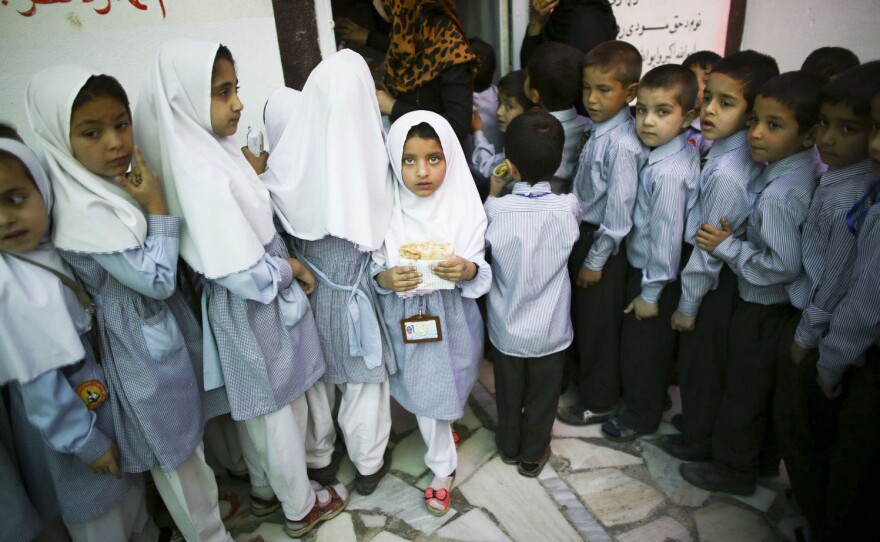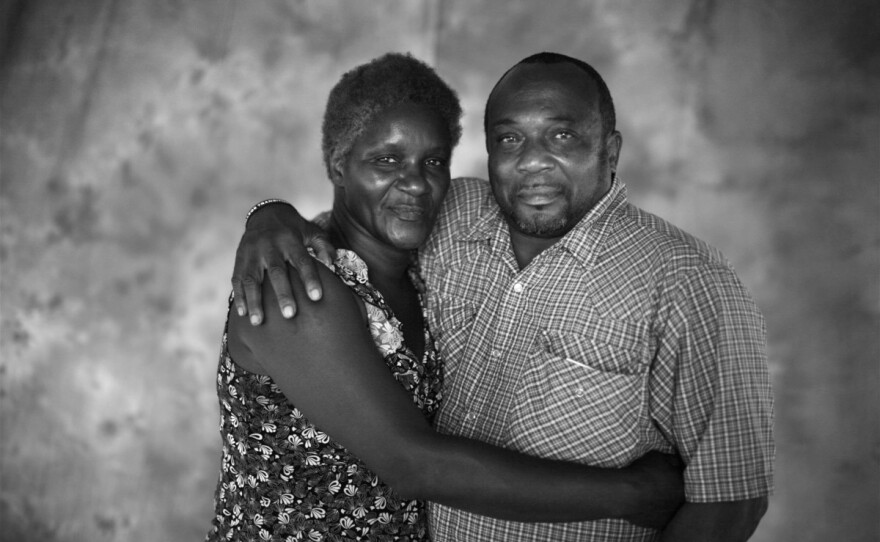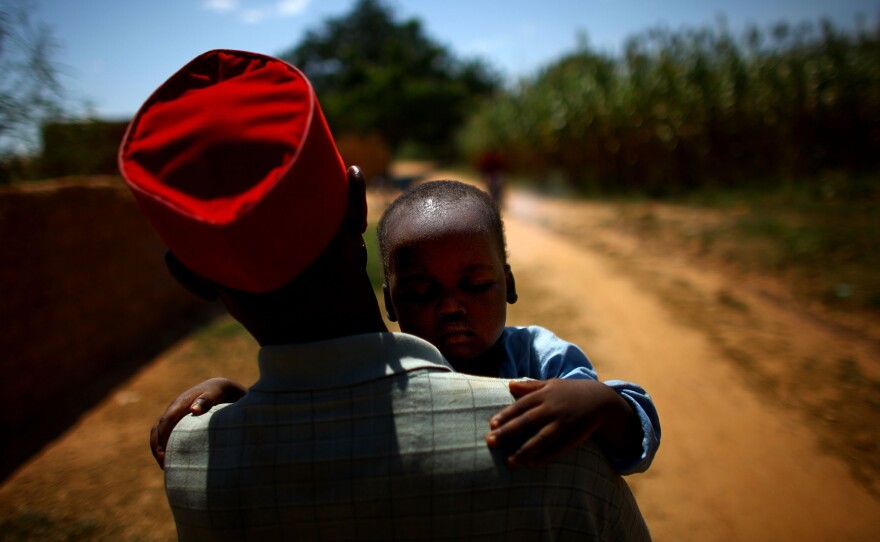How do you cover an incomprehensible disaster and make people connect with the real lives behind the headlines?
David Gilkey knew how.
His photos have helped define our coverage of global health and development at Goats and Soda. They have a tremendous warmth and humanity that reflects his own compassionate heart and soul.
Gilkey was killed on Sunday, June 5, 2016, on assignment for NPR in Afghanistan. His interpreter Zabihullah "Zabi" Tamanna died as well during a rocket-propelled grenade attack on their Humvee. Today marks the seventh anniversary of his death.
We asked his NPR colleagues, present and past, to pick a favorite photo and share a memory.

What A Funny Man
They all laughed when they saw him. What a funny man, with his sunburned cheeks and baseball cap. Cameras dangling off both shoulders. So tall! The 6- and 7-year-olds were most impressed. They moved around the trunks of his legs, cautious at first and then, when he looked down at them, all crinkly eyes and conspiratorial smile, a bit more daring. They pulled on his pants legs, jumped in front of the camera. Boys in front, girls around the edges. And he just waited and looked down at them, and shrugged at Zabi and me as we watched and laughed at him.
All morning he stood in that school courtyard in Kabul, Afghanistan, being his funny self until the kids were so comfortable they mostly forgot he was there. Eventually, they left his side in twos and threes, headed for the snack lines. Girls on the left, boys on the right. And when a 6-year-old girl emerged grasping her lunch, he stooped down and she looked up.

-Rebecca Hersher
Dawn In Afghanistan
This was dawn at Camp Dwyer in Helmand. It was superhot, and the early mornings were about the only time of day where the temperature was tolerable. We were two weeks into a monthlong trip, and had spent time with U.S. Special Forces in Wardak province, and then covered the closing up of the last U.S. Army outpost in the Arghandab River Valley. The last time David and I were together at Dwyer before this, it was all tents and baby powder dust, but by 2013, when I took this photo, there were hard roads and plywood buildings.
-Graham Smith

Portraits With Dignity
David shot dignity. That was the secret to his amazing portraits, which I saw him take from Alaska to Pakistan — people knew when they met him that they counted to him.
I'm hearing from American war vets he covered — some when they were climbing mountains, some when they were hitting rock bottom. One formerly homeless vet wrote, "I remember him being a kind man who tried to help me steal a cot, and bought me lunch. Thank you for the opportunity to meet him ... Til' Valhalla brother."
Afghan friends are calling me in grief and disbelief — guys who broke bread with David every time he visited Afghanistan, stayed with him when they came to the U.S. His loyalty as a friend met their standard. His dedication to those people leaves us with a terrible burden to pick up. I'm afraid no one can.
-Quil Lawrence

A Dying Boy
It's one of the most poignant images of the Ebola outbreak: a tiny, 10-year-old boy sick with Ebola lies dying in an alleyway in Liberia's capital as a neighbor covers him with a blanket.
"It was just gut-wrenching," Gilkey later told NPR's All Things Considered. "Because he was lying there all by himself, and everybody was walking by him, and he was, you know, slowly being covered in flies. It was really a scene of sort of a slow death. ... You just wanted to pick him up. You wanted to get him dressed, and you wanted to get him somewhere safe. But you couldn't."
You couldn't because Ebola was so contagious. And Gilkey didn't take the threat lightly. I remember sitting with him and NPR producer Nicole Beemsterboer in an airport lounge en route to Liberia. As we hammered out our plan, it became clear that David was really worried about the possibility of contracting Ebola. Nicole and I exchanged glances. This was one of the most battle-hardened photojournalists in the business — a man who had survived firefights in Afghanistan yet kept going back. If he was this afraid, what were any of us doing here?
But as soon as we hit the ground, we learned the true nature of David's celebrated bravery: It's not that he was fearless but rather that he was absolutely committed to putting his fears aside to do his journalism. And it's not that he was reckless, either. He was zealous about taking precautions. But there are risks you cannot control. We talked about this one night, when I confessed to feeling waves of dread wash over me each time we drove back into a particular neighborhood where we had been caught up in a violent riot a few days earlier. Sometimes, David counseled, you just have to push through the fear. It became our little mantra as we set out each morning. "Push through the fear!" Gilkey would call out, flashing his wry, crooked little grin.
-Nurith Aizenman
Following The Body Collectors
David spent two days shooting "They Are The Body Collectors: A Perilous Job In The Time Of Ebola." He followed a team charged with removing bodies of people who had died of — or were suspected of dying of — Ebola.
It was the most dangerous story we did. One drop of infected body fluid from a known victim of the virus could kill you. Yet he followed the collectors into houses and approached the bodies with them. He wanted to get it right.
I think that bears repeating: He went into the houses and up to the bodies, and he wanted to get it right.
This was August 2014. Our reporting team — David, myself and correspondent Nurith Aizenman — were among the first in Monrovia to document the Ebola crisis. No one was shaking hands for fear of transferring the virus; we soaked our shoes and hands in chlorine wash every time we went in and out of our hotel; officials took our temperature every time we entered a government building. People were so scared that there were fewer than five international journalists in all of Liberia.
David wanted to get it right because he knew that if he did, people would sit up and pay attention.
He spent another day on the script and "tracking" the video — that's the term we use to refer to a reporter's narration. We holed up in a hotel room, crouched over a laptop, going back through the video again and again and again, getting the script right, the words right. Then he burrowed away in a closet with a towel over him to track, with me just outside of it, holding the mic. He went over every word, every intonation, again and again, until he got it right.
The video and David's images were published, and people did sit up and pay attention. Thinking about that day and that trip, I can't shake this sinking feeling that there is so much work for him now left undone.
-Nicole Beemsterboer

A Delight To Edit
I mean, look at this guy. Gilkey made photo editing such a delight. I remember when this one came through. The story was about a rally in a remote Afghan village, where president Hamid Karzai was campaigning for re-election. People showed up in droves, some dressed to the nines. This photo has been hanging in my home for years, maybe because I've always thought this guy was like Gilkey's Afghan spirit animal, with a camera in hand and a clear appreciation for fine fashion accessories. He's wearing a DG (Dolce & Gabbana) belt. Rest in peace, DG.
-Claire O'Neill

Too Close With Comfort
In January 2009, David filed a heartbreaking story from the Gaza strip. I remember flipping through his images and being absolutely gutted by this portrait of 16-year-old Ahmed Samouni. David broke so many of the rules I had learned studying photojournalism. Editing his images was a re-education of sorts — extreme light, getting impossibly close to the subject, subjects dead center, like Ahmed, for maximum impact. I couldn't shake the innocence lost but captured in this image. Sitting at my desk, far from the reality of this moment, I became profoundly aware of the toll living through these images must have taken on him. I'm deeply thankful for all he taught me as a photographer, and for all his tips when it came to our shared love of leather boots and expensive bags. I hugged him goodbye the day he left for Afghanistan and said, as always, "see you soon." How sincerely I wish that were true.
-Becky Lettenberger
David Gilkey (or just "Gilkey" as we all called him) had an amazing ability to see both lightness and darkness — and to photograph the edges between the two. In this photo of a boy in Gaza after an Israeli attack destroyed his town, we see the boy, staring straight into the lens, haunted and traumatized, a shaft of light illuminating just half his face. But the photo takes on a deeper meaning when we start to think about the lightness and darkness within us all. David was able to take his camera to the darkest places in the world and with his camera would find the lightness of spirit that connects us all.
-Coburn Dukehart

Little Buddies
The images that I remember the most aren't the ones we edited for his stories, but the images in between the action. The images where you could feel David's presence in the room. David was a big dude — over 6 feet tall, bald, with a beard. On top of that, his slightly round belly made him seem like a real-life Santa Claus or a big, gentle bear. Awestruck at the sight of him, children would stand at attention and just stare. Then they'd start to smile and inch near to touch him — and his camera would catch them.
We'd affectionately call the children in these images his "little buddies." And while they rarely made the final cut into our stories, they are the ones that I think about when I think of David. He talked often of the hope that his images would have an impact on our audience. But I like to believe he had an equal impact on the people whose stories he told.
-Kainaz Amaria
The Lady In Red
I just love this picture because it captured the starkness of the hospital — these two drab, white tents which are the wards — and this regal figure in a bright red dress, walking through the middle of the frame. Gilkey took this picture in February when we spent a week at the Doctors Without Borders field hospital in a refugee camp in South Sudan.
-Jason Beaubien

A Dad And His Son
We came to Northern Nigeria in 2012 to look at the efforts to wipe out polio in Africa. This boy, being carried by his father, was one of the last cases on the continent. That photo captured for me how awful polio is for a father. There's something about the body language of the father that says a lot, and it seems to me that Gilkey was great at capturing very human moments like that.
-Jason Beaubien

A City He Loved
I did this profile of a rowing coach in Portland last fall, and David was around then — he lived in Portland — and shot photos. I remember thinking what a cool, humble guy David seemed like. My story hardly was about famine or war, but David didn't make it seem as if a sports story was beneath him. Because I don't think he felt that way. He was engaged, and you can see the care and interest and love of the city through his work. He was a journalist and artist, whatever the subject. A kind person as well. Quite a mix.
-Tom Goldman
Copyright 2023 NPR. To see more, visit https://www.npr.org. 9(MDAzMjM2NDYzMDEyMzc1Njk5NjAxNzY3OQ001))






